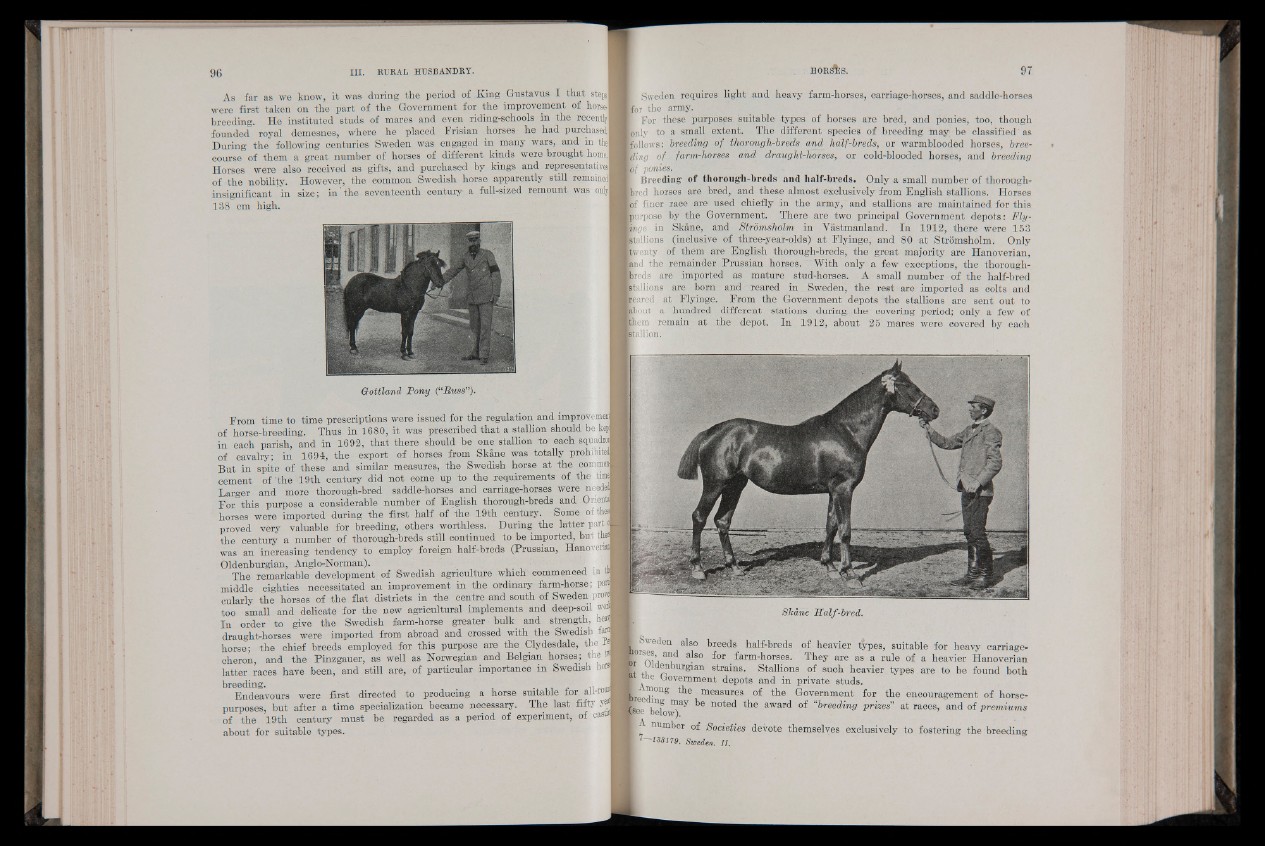
| Sweden requires light and heavy farm-horses, earriage-horses, and saddle-horses
I tor the army.
I For these purposes suitable types of horses are bred, and ponies, too, though
I fcnly to a small extent. The different species of breeding may be classified ' as
Bellows: breeding of thorough-breds and half-breds, or warmblooded horses, breed
in g of farm-horses and draught-Horses, or cold-blooded horses, and breeding
t)/ ponies,' v
I Breeding of tliorongh-breds and half-breds. Only a small number of thorough-
K jred horses are bred, and these almost exclusively from English stallions. Horses
H>f finer race are used chiefly in the army, and stallions are maintained for this
■nirpose by the Government. There are two principal Government depots: Fly-
■W e in Skane, and Stromsholm in Vastmanland. In 1912, there were 153
■stallions (inclusive of three-year-olds) at Flyinge, and 80 at Stromsholm. Only
■twenty of them are English thorough-breds, the great majority are Hanoverian,
■and the remainder Prussian horses. With only a few exceptions, the thorough-
■Ireds are imported as mature stud-horses. A small number of the half-bred
KtallionB are bom and reared in Sweden, the rest are imported as colts and
■reared at Flyinge. From the Government depots the stallions are sent out to
■about a hundred different stations during the covering period; only a few of
Rhom remain at the depot. In 1912, about 25 mares were covered by each
■stallion.
As far as we know, it was during the period of King Gustavus I that stepj
were first taken on the part of the Government for the improvement of horse-
breeding. He instituted studs of mares and even riding-schools in the recently
founded royal demesnes, where he placed Frisian horses he had purchased;
During the following centuries Sweden was engaged in many wars, and in the
course of them a great number of horses of different kinds were brought home,
Horses were also received as gifts, and purchased by kings and representative!
of the nobility. However, the common Swedish horse apparently still remained
insignificant in size; in the seventeenth century- a full-sized remount was only
138 cm high.
Gottland Pony {“Russ”).
From time to time prescriptions were issued for the regulation and improvemen I
of horse-breeding. Thus in 1680, it was prescribed that a stallion should be kepjl
in each parish, and in 1692, that there should be one stallion to each squadijl
of cavalry; in 1694, the export of horses from Skane was totally prohibited
But in spite of these and similar measures, the Swedish horse at the comma
cement of 'the 19th century did not come up to the requirements of the timj
Larger and more thorough-bred saddle-horses and carriage-horses were needed
For this purpose a considerable number of English thorough-breds and Orient!
horses were imported during the first half of the 19th century. Some ofthd
proved very valuable for breeding,. others -worthless. ■ D u r i n g the latter part
the century a number of thorough-breds still continued to be imported, but thel
was an increasing tendency to employ foreign half-breds (Prussian, Hanovenij
Oldenburgian, Anglo-Norman). ■' -v ' y |
The remarkable development, of Swedish agriculture which commenced in «
middle eighties necessitated an improvement in the ordinary farm-horse; pW
cularly the horses of the flat districts in the centre and. south of Sweden proti
too small and delicate for the new agricultural implements and deep-soil wotl
In order to give the Swedish farm-horse greater ■ bulk and strength, heat
draught-horses were imported from abroad and crossed with the Swedish fwj
horse; the chief breeds employed for this purpose are the Clydesdale,jythe hj
cheron, and the Pinzgauer, as well as Norwegian and Belgian h o r s e s ; the M
latter races have been, and still are, of particular importance in Swedish hot*
h tP f idlTlg . ,
Endeavours were first directed to producing a horse suitable for all-»««
purposes, but after a time specialization became necessary. The last , fifty ?
of the 19th century must be regarded as a period of experiment, of caswl
about for suitable types.
I ' en also breeds half-breds of heavier types, suitable for heavy carriageai^
a?S° ^0T ^arm-horses. They are as a rule of a heavier Hanoverian
fct tn ®^eurgian strains. Stallions of such heavier types are to be found both
■ A 6 v e r n i n e i l t depots and in private studs.
br<:-'!r°n^ measllre3 ° f the Government for the encouragement of horse-
f s e e b e f o w ) ^ ^ n° te<^ awarc* “breeding prizes” at races, and of premiums
R A number of Societies devote themselves exclusively to fostering the breeding
133179. Sweden. II.
A,'
Skane Half-bred.